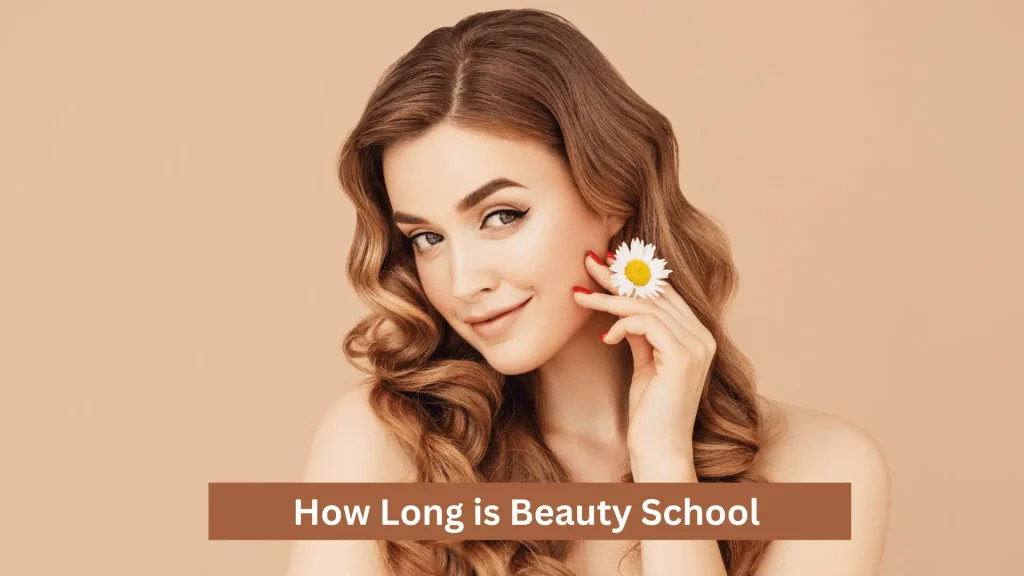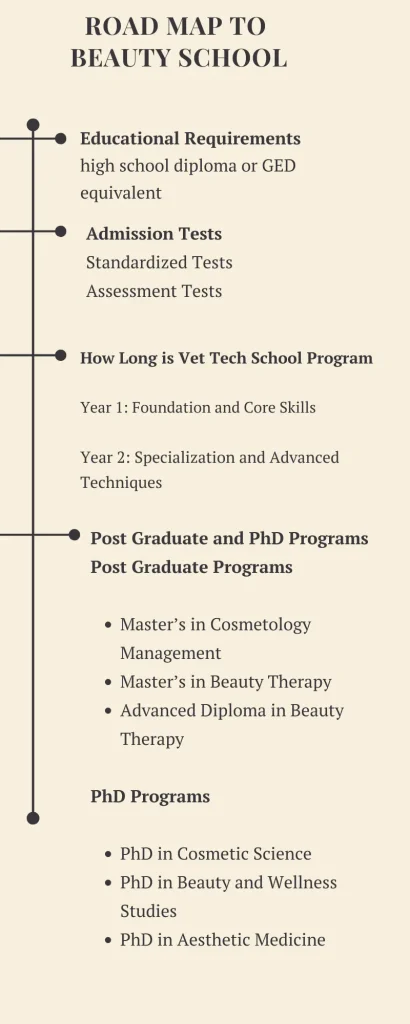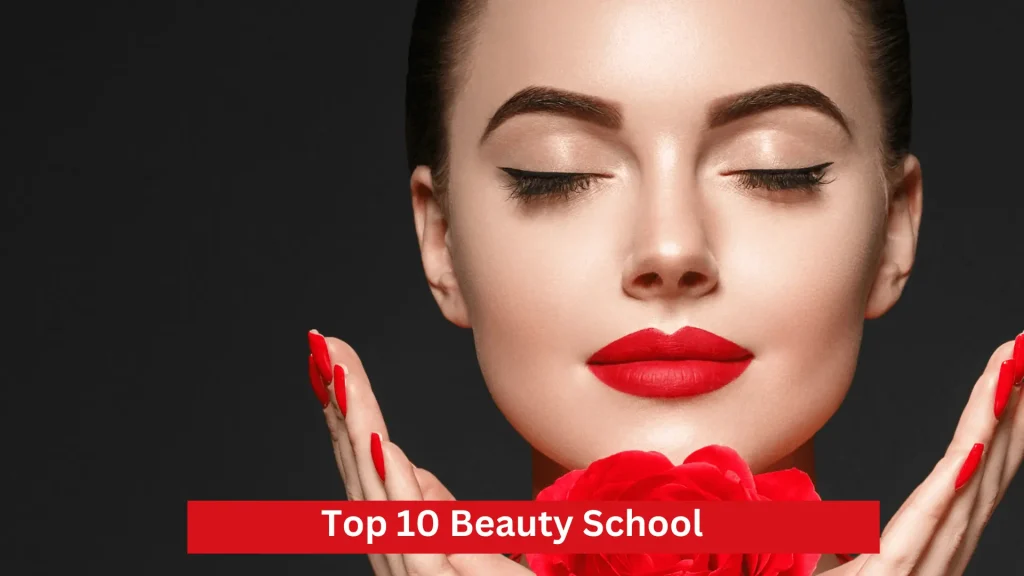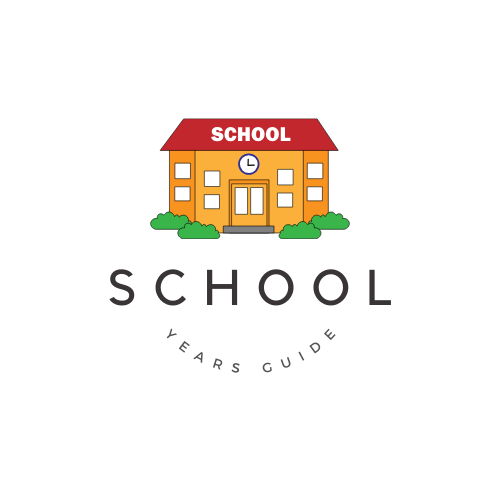How Long is Beauty School
How Long is Beauty School? The duration of beauty school varies, but typically, it takes between 9 months to 2 years to complete a program. The exact length depends on the state requirements and the specific program chosen. Students should research to find the best fit for their goals and schedule.
What is Beauty School
Beauty school is an educational institution where students learn various cosmetology skills, such as hairstyling, makeup artistry, skincare, and nail technology. These programs combine theoretical knowledge with hands-on training to prepare students for careers in the beauty industry. Graduates can pursue various roles, including hairstylists, estheticians, and makeup artists.

Attending beauty school involves studying anatomy, sanitation, and state-specific regulations, ensuring students are well-prepared for licensing exams. The curriculum also emphasizes practical experience, allowing students to work with real clients under supervision. This comprehensive training helps graduates build a strong foundation for a successful career in the beauty field.
How Long is Beauty School
1. Beauty schools typically offer various programs ranging from certificates to associate degrees. An undergraduate program, particularly an associate degree, is usually structured over two years. Below is a detailed breakdown of what each year in such a program might entail:
Year 1: Foundation and Core Skills
Semester 1:
Introduction to Cosmetology: Covers the history, ethics, and career opportunities in the beauty industry.
Sanitation and Safety: Focuses on maintaining hygiene standards and safety procedures.
Basic Haircutting and Styling: Teaches fundamental haircutting techniques and basic styling methods.
Skin Care Basics: Introduction to skin anatomy, facial treatments, and basic skincare routines.
Nail Technology: Basics of nail care, including manicures, pedicures, and nail art.
Semester 2:
Advanced Haircutting and Styling: Builds on basic skills, introducing advanced techniques and creative styles.
Hair Coloring and Chemical Services: Techniques for coloring hair, highlights, and chemical treatments like perms and relaxers.
Facials and Skincare Treatments: Advanced skin treatments, including facial massage, masks, and peels.
Makeup Application: Fundamentals of makeup artistry, color theory, and product knowledge.
Salon Management Basics: Introduction to the business side of running a salon, including customer service and basic bookkeeping.
Year 2: Specialization and Advanced Techniques
Semester 3:
Specialized Hair Services: Techniques for special occasions, such as weddings and events, including updos and intricate styles.
Advanced Skin Treatments: Microdermabrasion, chemical peels, and other advanced facial treatments.
Advanced Makeup Techniques: Bridal, theatrical, and special effects makeup.
Client Consultation and Communication: Skills for effective client interactions, consultations, and personalized service plans.
Elective Courses: Options might include aromatherapy, spa management, or advanced nail technology.
Semester 4:
Clinical Practice/Externship: Hands-on experience in a real salon or spa setting, applying learned techniques on clients under supervision.
Salon and Spa Management: In-depth study of running a beauty business, including marketing, finance, and human resources.
State Board Exam Preparation: Comprehensive review and practice exams to prepare for state licensing exams.
Portfolio Development: Creating a professional portfolio showcasing skills and work completed during the program.
Job Placement and Career Planning: Assistance with job searches, resume writing, and interview preparation.

How to Enter Beauty School
Educational Requirements
High School Diploma or GED
Most beauty schools require applicants to have a high school diploma or equivalent (GED).
Some programs may accept students still in high school through dual enrollment programs.
Minimum Age Requirement
Typically, applicants must be at least 16 or 17 years old. Specific age requirements can vary by state and institution.
Basic Skills
Proficiency in basic math and reading skills is often required.
Some schools may require a skills assessment test to ensure applicants can handle the coursework.
Entry Tests
Placement Tests
Some beauty schools may require placement tests to assess the applicant’s knowledge in basic subjects like math and English.
These tests help determine if any remedial courses are necessary before starting the beauty program.
Interview
An interview may be part of the entry process to assess the applicant’s interest in the beauty industry and career goals.
This interview can also serve to explain the program’s requirements and expectations.
Application Process
Research and Select Schools
Research different beauty schools to find programs that match your career goals, budget, and location preferences.
Consider factors like program length, curriculum, accreditation, and job placement rates.
Complete Application Form
Fill out the application form available on the school’s website or at the admissions office.
Provide necessary personal information, educational background, and program of interest.
Submit Transcripts and Documentation
Submit high school transcripts or GED certification.
Provide any additional documents requested, such as proof of age or identification.
Write a Personal Statement
Some schools may require a personal statement explaining why you want to pursue a career in the beauty industry.
Highlight relevant experiences, skills, and career aspirations.
Letters of Recommendation
Obtain letters of recommendation from teachers, employers, or mentors who can attest to your skills and character.
Not all schools require this, but it can strengthen your application.
Application Fee
Pay the application fee, if required. The fee amount varies by institution.
Financial Aid Application
Complete the Free Application for Federal Student Aid (FAFSA) to determine eligibility for federal financial aid.
Check with the school for additional financial aid forms or requirements.
Interview
Attend an interview, if required, to discuss your application and career goals.
Financial Aid
Federal Financial Aid
Grants: Such as the Pell Grant, which does not need to be repaid.
Loans: Federal student loans like the Direct Subsidized Loan and Direct Unsubsidized Loan.
Work-Study: Federal Work-Study Program offers part-time employment to help pay for education expenses.
State Financial Aid
Check with your state’s education department for grants, scholarships, and loans available to residents attending beauty school.
Institutional Scholarships
Many beauty schools offer their own scholarships based on merit, need, or specific criteria (e.g., diversity scholarships, artistic talent).
Private Scholarships and Grants
Numerous private organizations, foundations, and companies offer scholarships specifically for students pursuing careers in cosmetology and related fields.
Payment Plans
Many schools offer flexible payment plans that allow students to pay tuition in installments rather than a lump sum.
Employer Sponsorship
Some employers in the beauty industry may offer sponsorship or tuition reimbursement programs for employees pursuing further education.
Veterans Benefits
Veterans and active-duty military personnel may be eligible for educational benefits through the GI Bill.
Community and Professional Organization Scholarships
Organizations such as the American Association of Cosmetology Schools (AACS) and the Professional Beauty Association (PBA) offer scholarships and grants.
Post Graduate and PhD Programs for Beauty School
Post Graduate Programs
Master’s in Cosmetology Management
Overview: Advanced business training for beauty industry professionals focusing on management, leadership, and strategic planning.
Duration: 1-2 years.
Curriculum: Includes courses in business administration, marketing strategies, advanced cosmetology, and salon management.
Career Paths: Salon owner, spa manager, beauty consultant.
Master’s in Beauty Therapy
Overview: Advanced study of therapeutic techniques and wellness in the beauty industry.
Duration: 1 year.
Curriculum: Covers advanced skincare treatments, therapeutic massage, and wellness strategies.
Career Paths: Senior beauty therapist, wellness coach, beauty therapy educator.
Advanced Diploma in Beauty Therapy
Overview: Specialized training in advanced beauty therapies and techniques.
Duration: 6 months to 1 year.
Curriculum: Includes advanced skin care, laser therapies, and aesthetic procedures.
Career Paths: Advanced beauty therapist, clinic manager, aesthetic consultant.
Certificate in Advanced Aesthetics
Overview: Focuses on cutting-edge aesthetic treatments and technologies.
Duration: 6 months to 1 year.
Curriculum: Advanced facial treatments, injectables, and laser aesthetics.
Career Paths: Aesthetic practitioner, beauty clinic specialist.
Diploma in Makeup Artistry
Overview: Advanced training in professional makeup techniques for various applications.
Duration: 6 months to 1 year.
Curriculum: Advanced makeup techniques, special effects, and professional portfolio development.
Career Paths: Professional makeup artist, makeup educator, special effects artist.
PhD Programs
PhD in Cosmetic Science
Overview: Research-focused program exploring cosmetic product development and innovation.
Duration: 3-5 years.
Curriculum: Advanced research methods, cosmetic chemistry, and product formulation.
Career Paths: Cosmetic chemist, product developer, academic researcher.
PhD in Beauty and Wellness Studies
Overview: In-depth research on beauty practices and wellness.
Duration: 3-5 years.
Curriculum: Research in beauty science, wellness therapies, and therapeutic practices.
Career Paths: Research scientist, wellness program director, university professor.
PhD in Aesthetic Medicine
Overview: Advanced study of medical aesthetics and clinical practice.
Duration: 3-5 years.
Curriculum: Advanced aesthetic treatments, clinical research, patient care strategies.
Career Paths: Medical aesthetician, cosmetic surgeon, research academic.
PhD in Salon and Spa Management
Overview: Research-oriented program in salon and spa business management.
Duration: 3-5 years.
Curriculum: Business management, financial planning, strategic development for salons and spas.
Career Paths: Spa director, business consultant, academic researcher.
PhD in Integrative Beauty Therapies
Overview: Research program combining traditional and modern beauty therapies.
Duration: 3-5 years.
Curriculum: Integrative therapy research, traditional techniques, modern beauty
practices.
Career Paths: Integrative therapy practitioner, beauty research specialist, educator
Top 10 Beauty School
Choosing a top beauty school can depend on various factors such as program offerings, reputation, facilities, and alumni success. Here are ten highly regarded beauty schools in the United States:

Aveda Institutes
Locations: Multiple campuses nationwide (e.g., New York, NY; Los Angeles, CA)
Highlights: Known for their natural and environmentally-friendly approach to beauty education. Offers programs in cosmetology, esthiology, and massage therapy.
Paul Mitchell Schools
Locations: Multiple campuses nationwide (e.g., Costa Mesa, CA; Orlando, FL)
Highlights: Focuses on hands-on training and career development. Offers programs in cosmetology, barbering, skin care, and nail care.
Empire Beauty Schools
Locations: Multiple campuses nationwide (e.g., Atlanta, GA; Manhattan, NY)
Highlights: Offers comprehensive cosmetology programs with a focus on career placement. Also provides specialized programs in esthetics and makeup artistry.
Pivot Point Academy
Location: Multiple campuses worldwide
Highlights: Known for their innovative approach to beauty education, including digital learning tools and an international curriculum. Offers programs in cosmetology and esthetics.
The Sassoon Academy
Location: Santa Monica, CA
Highlights: Renowned for their cutting-edge techniques and precision in haircutting and styling. Offers advanced training courses for professionals.
Ogle School
Locations: Multiple campuses in Texas (e.g., Dallas, TX; Houston, TX)
Highlights: Offers cosmetology, esthetics, and makeup programs. Known for their strong focus on hands-on training and career services.
Bellus Academy
Locations: Multiple campuses in California and Kansas
Highlights: Provides a wide range of beauty programs including cosmetology, barbering, esthetics, and spa therapies. Known for their advanced training and career placement support.
Marinello Schools of Beauty
Locations: Multiple campuses in California, Nevada, and Utah
Highlights: Offers a variety of programs in cosmetology, esthetics, and manicuring. Known for their extensive hands-on training and career services.
Tricoci University of Beauty Culture
Locations: Multiple campuses in Illinois and Indiana
Highlights: Founded by renowned hairstylist Mario Tricoci. Offers programs in cosmetology, esthetics, barbering, and nail technology.
International Beauty School
Locations: Multiple campuses (e.g., Martinsburg, WV; Cumberland, MD)
Highlights: Offers comprehensive programs in cosmetology, esthetics, and nail technology. Known for their personalized training and career services.
Final Verdict
In conclusion, the length of beauty school programs is influenced by various factors, including program type, state requirements, enrollment status, curriculum structure, and financial constraints. Understanding these elements helps prospective students make informed decisions about their education and career path in the beauty industry.
FAQs
1.What is the typical duration of a cosmetology program?
Answer: The typical duration of a cosmetology program ranges from 9 months to 2 years, depending on whether the student is enrolled full-time or part-time and the specific state requirements for training hours.
2.How do state requirements affect the length of beauty school programs?
Answer: State requirements affect the length of beauty school programs by mandating a specific number of training hours and course content that students must complete to obtain licensure. For example, California requires 1,600 hours for cosmetology, while New York requires 1,000 hours.
3.Can prior experience in beauty or cosmetology shorten the length of a beauty school program?
Answer: Yes, prior experience or previous certifications in beauty or cosmetology can potentially shorten the length of a beauty school program. Some schools may offer credit for previous training or experience, allowing students to complete the program faster.
4.What financial aids are available for beauty school students, and how do they impact program length?
Answer: Financial aids for beauty school students include scholarships, grants, loans, and work-study programs. Availability of financial aid can impact program length by enabling students to enroll full-time and complete their education more quickly, whereas financial constraints might necessitate part-time enrollment, extending the program duration.
5.How does the choice between full-time and part-time enrollment impact the duration of a beauty school program?
Answer: Full-time enrollment typically allows students to complete a beauty school program in a shorter period, often within 9 to 12 months. In contrast, part-time enrollment, which accommodates students’ work or personal schedules, can extend the program length to 1.5 to 2 years or more.
